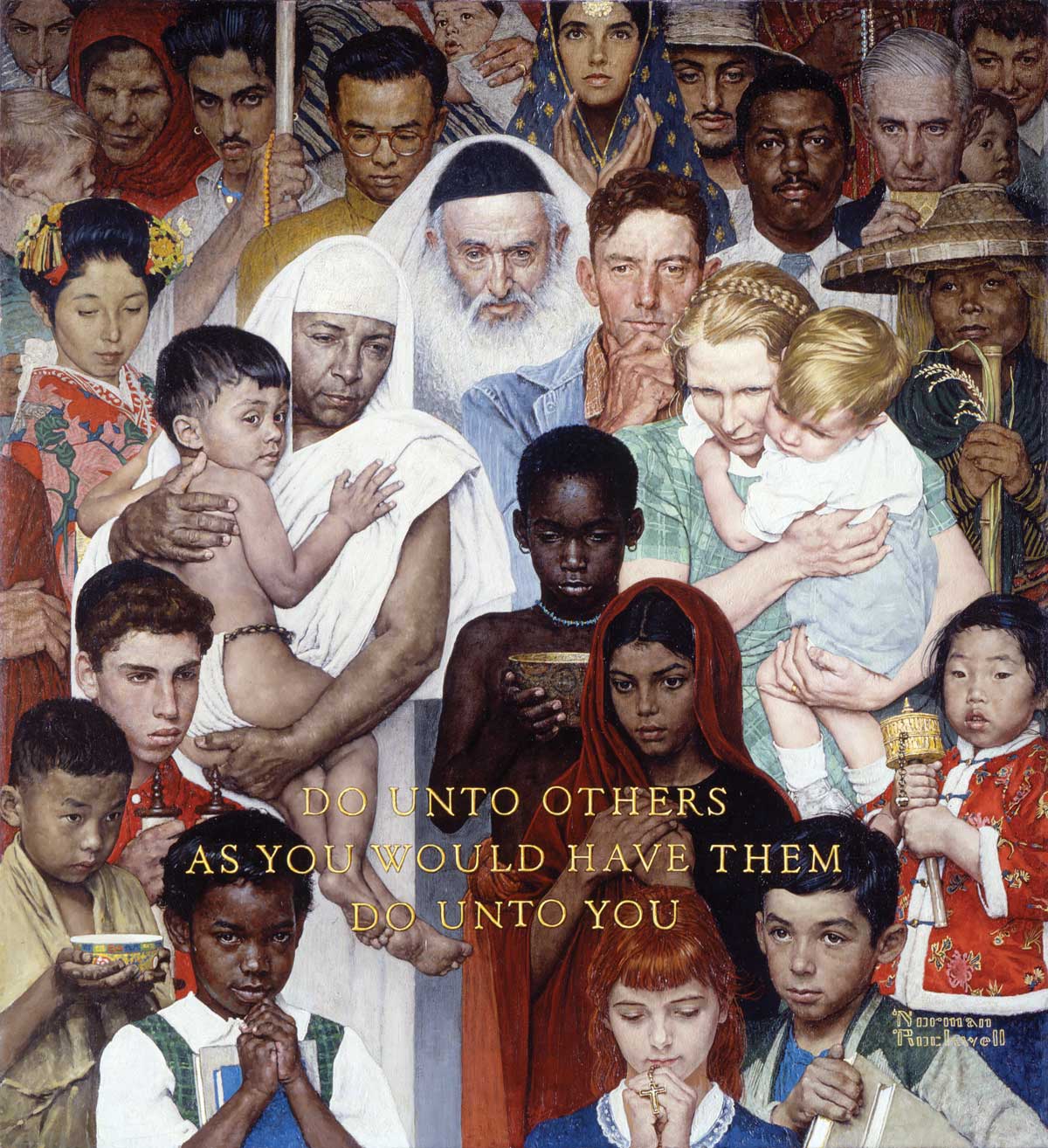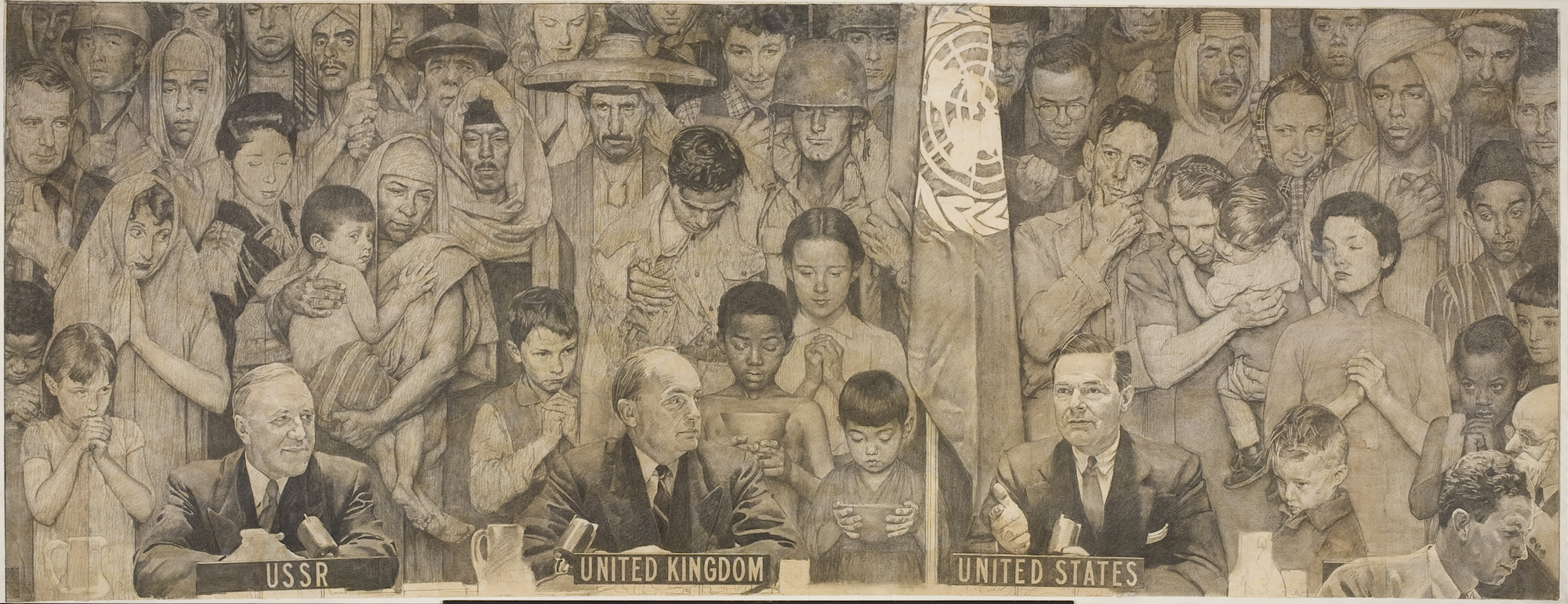Close Reading of the Golden Rule
Overview:
Students closely examine Norman Rockwell's illustration, The Golden Rule, and then learn background information about it. Students share details regarding the people, objects, composition, color, and lighting, among other visual elements. They make supported inferences about the messages conveyed by the painting and the ways in which they have been communicated.
Enduring Understandings/ Essential Questions:
- There are virtues, including honesty, mutual respect, and cooperation, among others, which should be reflected in all of our interactions with the people we encounter in our lives.
- Equality, freedom, liberty, and respect for others are important principles in our world.
- People may have different ideas about the same topic. Everyone has the right to have their ideas heard as long as they present them respectfully, and are willing to afford others that opportunity as well.
- How should people treat others in their community?
- Why may people have different ideas about the same thing?
- Why should people who have ideas that are different from yours be allowed to share their ideas?
- Grade
- 3-5
- Theme
- Four Freedoms
- Length
- This activity may be completed in one 30 to 40 minute period.
- Discipline
- Social Studies; Language Arts: Reading
- Vocabulary
- Principles; Freedom; Liberty; Respect; Rights; Equality; Honesty; Cooperation; Perspective; United Nations; Virtues
Objectives:
- Students will close read the illustration, Golden Rule, by Norman Rockwell, sharing the things that they notice about the painting.
- Students will make inferences supported by the details in the illustration.
- Students will discuss the purpose and message of this painting, including the relevance of the phrase, “Do Unto Others As You Would You Have Them Do Unto You.”
- Students will think about how people should treat each other.
Background:
Golden Rule, 1961
Cover illustration for The Saturday Evening Post, April 1, 1961
Oil on canvas
Norman Rockwell Museum Collection, NRACT.1973.010
Golden Rule, a gathering of men, women, and children of different races, religions, and ethnicities, was a precursor of the socially conscious subjects that Norman Rockwell would undertake in the 1960s. “Do Unto Others as You Would Have Them Do Unto You” was a simple but universal phrase that reflected the artist’s personal philosophy. A citizen of the world, Rockwell traveled throughout his life and was welcomed wherever he went. Of the painting Rockwell said, “I had tried to depict all the peoples of the world gathered together. That is just what I wanted to express about the Golden Rule.” The painting features five mothers holding their children. In the top right, the artist’s wife Mary Barstow Rockwell holds the Rockwell’s first grandchild, Geoffrey. Unfortunately, Mary died in 1959 before Geoffrey was born, and the painting allowed Rockwell to bring them together.
Rockwell’s Golden Rule painting later served as the inspiration for a glass mosaic that was presented to the United Nations in 1985 as a Fortieth Anniversary gift on behalf of the United States by then First Lady Nancy Reagan, made possible by the Thanks-Giving Square Foundation. Rockwell’s Golden Rule painting and his United Nations drawing were exhibited at the United Nations in honor of this humanitarian organization’s Seventieth Anniversary of the United Nations, an expression of his appreciation for humanity and democratic ideals.
Things to Notice About Norman Rockwell’s Golden Rule
- Mothers of different cultures holding their children
- Mary Rockwell, Norman Rockwell’s wife and the mother of their three sons, holding their first grandchild, Geoffrey Rockwell. Mary had died before Geoffrey was born, but Rockwell brought them together in this work.
- Clothing and objects representing different cultures
Background on Norman Rockwell’s United Nations
In 1952, at the height of the Cold War and two years into the Korean War, Rockwell conceived an image of the United Nations as the world’s hope for the future. His appreciation for the organization and its mission inspired a complex work portraying members of the Security Council and many people representing the nations of the world—a study for an artwork that he originally intended to complete in painted form. Researched and developed to the final drawing stage, the artist’s United Nations never actually made it to canvas. Rockwell’s desire to reach out to a global community and emphasize the commonality of mankind found its forum on the cover of The Saturday Evening Post in Golden Rule, nine years later, in 1961.
Of his work on the United Nations drawing, Rockwell said, “Like everyone else, I’m concerned with the world situation, and like everyone else, I’d like to contribute something to help. The only way I can contribute is through my pictures.”
Norman Rockwell
United Nations 1953
Study for an unfinished illustration
Pencil and charcoal on paper
Norman Rockwell Museum Collection
NRACT.1973.113 (M57)
Materials:
Multimedia Resources
Golden Rule
United Nations
Classroom Supplies:
- Chart paper with T-Chart labeled “What I See”/”What I wonder”
- Marker
Activities:
- Display Norman Rockwell’s Golden Rule.
- Ask students to look carefully at the illustration. Give them a few minutes to do this. Bring students together in a circle and ask each student to share one thing they observe about the painting. Record their observations.
- Turn and Talk: When you feel enough time has passed, have students turn to a person sitting beside them. Ask them what they wonder about the painting. As they are sharing, listen in to their conversations.
- Have partners share some of the things they noticed and wondered about in the picture. Record their responses on chart paper. Elicit observations heard during partner talk that are not shared or share them for the students.
- Have partners share their thinking. Record responses on the T-chart. Elicit details from the picture to support their findings.
- New observations may be contributed as they look closer; add them to the appropriate column on T-Chart.
- If you have not already done so, share the origin of the painting and its name. Have students reflect on the message that Rockwell was hoping to convey, and what the message means to them.
Optional: If students have had guided opportunities to close read other illustrations, they may work independently or with a partner to complete the included T-chart graphic organizer. They can refer to their recorded observations and inferences when everyone gathers to share and discuss the illustration.
Assessment:
- Did everyone participate?
- Are students basing their thinking on the details?
- Do student responses to the illustration reflect civic virtues/ principles?
Standards
This curriculum meets the standards listed below. Look for more details on these standards please visit: ELA and Math Standards, Social Studies Standards, Visual Arts Standards.
- CCSS.ELA-Literacy.RL.3.1
- Ask and answer questions to demonstrate understanding of a text, referring explicitly to the text as the basis for the answers.
- CCSS.ELA-Literacy.RL.3.3
- Describe characters in a story (e.g., their traits, motivations, or feelings) and explain how their actions contribute to the sequence of events
- CCSS.ELA-Literacy.RL.3.4
- Determine the meaning of words and phrases as they are used in a text, distinguishing literal from nonliteral language.
- CCSS.ELA-Literacy.RL.3.7
- Explain how specific aspects of a text's illustrations contribute to what is conveyed by the words in a story (e.g., create mood, emphasize aspects of a character or setting)
- CCSS.ELA-Literacy.RL.4.1
- Refer to details and examples in a text when explaining what the text says explicitly and when drawing inferences from the text.
- CCSS.ELA-Literacy.RL.4.3
- Describe in depth a character, setting, or event in a story or drama, drawing on specific details in the text (e.g., a character's thoughts, words, or actions).
- CCSS.ELA-Literacy.RL.4.4
- Determine the meaning of words and phrases as they are used in a text, including those that allude to significant characters found in mythology (e.g., Herculean).
- CCSS.ELA-Literacy.RL.4.7
- Make connections between the text of a story or drama and a visual or oral presentation of the text, identifying where each version reflects specific descriptions and directions in the text.
- CCSS.ELA-Literacy.RL.5.1
- Quote accurately from a text when explaining what the text says explicitly and when drawing inferences from the text.
- CCSS.ELA-Literacy.RL.5.3
- Compare and contrast two or more characters, settings, or events in a story or drama, drawing on specific details in the text (e.g., how characters interact).
- CCSS.ELA-Literacy.RL.5.4
- Determine the meaning of words and phrases as they are used in a text, including figurative language such as metaphors and similes.
- CCSS.ELA-Literacy.RL.5.7
- Analyze how visual and multimedia elements contribute to the meaning, tone, or beauty of a text (e.g., graphic novel, multimedia presentation of fiction, folktale, myth, poem).
- CCSS.ELA-Literacy.SL.3.1
- Engage effectively in a range of collaborative discussions (one-on-one, in groups, and teacher-led) with diverse partners on grade 3 topics and texts, building on others' ideas and expressing their own clearly.
- CCSS.ELA-Literacy.SL.3.2
- Determine the main ideas and supporting details of a text read aloud or information presented in diverse media and formats, including visually, quantitatively, and orally.
- CCSS.ELA-Literacy.SL.3.3
- Ask and answer questions about information from a speaker, offering appropriate elaboration and detail.
- CCSS.ELA-Literacy.SL.3.6
- Speak in complete sentences when appropriate to task and situation in order to provide requested detail or clarification. (See grade 3 Language standards 1 and 3 [link to="CCSS.ELA-Literacy.L.3"]here[/link] for specific expectations.)
- CCSS.ELA-Literacy.SL.4.1
- Engage effectively in a range of collaborative discussions (one-on-one, in groups, and teacher-led) with diverse partners on grade 4 topics and texts, building on others' ideas and expressing their own clearly.
- CCSS.ELA-Literacy.SL.4.2
- Paraphrase portions of a text read aloud or information presented in diverse media and formats, including visually, quantitatively, and orally.
- CCSS.ELA-Literacy.SL.4.3
- Identify the reasons and evidence a speaker provides to support particular points.
- CCSS.ELA-Literacy.SL.4.6
- Differentiate between contexts that call for formal English (e.g., presenting ideas) and situations where informal discourse is appropriate (e.g., small-group discussion); use formal English when appropriate to task and situation. (See grade 4 Language standards 1 [link to="CCSS.ELA-Literacy.L.4"]here[/link] for specific expectations.)
- CCSS.ELA-Literacy.SL.5.1
- Engage effectively in a range of collaborative discussions (one-on-one, in groups, and teacher-led) with diverse partners on grade 5 topics and texts, building on others' ideas and expressing their own clearly.
- CCSS.ELA-Literacy.SL.5.2
- Summarize a written text read aloud or information presented in diverse media and formats, including visually, quantitatively, and orally.
- CCSS.ELA-Literacy.SL.5.3
- Summarize the points a speaker makes and explain how each claim is supported by reasons and evidence.
- CCSS.ELA-Literacy.SL.5.6
- Adapt speech to a variety of contexts and tasks, using formal English when appropriate to task and situation. (See grade 5 Language standards 1 and 3 [link to="CCSS.ELA-Literacy.L.5"]here[/link] for specific expectations.)
- D1.1.3-5
- Explain why compelling questions are important to others (e.g., peers, adults).
- D1.2.3-5.
- Identify disciplinary concepts and ideas associated with a compelling question that are open to different interpretations.
- D1.4.3-5.
- Explain how supporting questions help answer compelling questions in an inquiry.
- D2.Civ.10.3-5.
- Identify the beliefs, experiences, perspectives, and values that underlie their own and others' points of view about civic issues.
- D2.Civ.7.3-5.
- Apply civic virtues and democratic principles in school setttings.
- D2.Civ.9.3-5.
- Use deliberative processes when making decisions or reaching judgements as a group.
- D3.2.3-5.
- Use distinctions among fact and opinion to determine the credibility of multiple sources.
- D4.2.3-5.
- Construct explanations using reasoning, correct sequence, examples, and details with relevant information and data.
- D4.4.3-5.
- Critique arguments.

